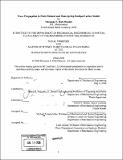| dc.contributor.advisor | James H. Williams, Jr. | en_US |
| dc.contributor.author | Holt-Phoenix, Marianne S. (Marianne Shue) | en_US |
| dc.contributor.other | Massachusetts Institute of Technology. Dept. of Mechanical Engineering. | en_US |
| dc.date.accessioned | 2007-01-10T17:02:01Z | |
| dc.date.available | 2007-01-10T17:02:01Z | |
| dc.date.copyright | 2006 | en_US |
| dc.date.issued | 2006 | en_US |
| dc.identifier.uri | http://hdl.handle.net/1721.1/35683 | |
| dc.description | Thesis (Nav. E. and S.M.)--Massachusetts Institute of Technology, Dept. of Mechanical Engineering, 2006. | en_US |
| dc.description | Includes bibliographical references (p. 42). | en_US |
| dc.description.abstract | Numerical efficiency comparisons of a four-node finite element model (FEM), a mass-spring lattice model (MSLM), and a mass-spring-dashpot lattice model (MSDLM) are investigated. Specifically, the error in the ultrasonic phase speed with variations in Poisson's ratio and angle of incidence is evaluated in each model of an isotropic elastic solid. With regard to phase speed, materials with constant N grid spaces per P-wavelength having Poisson's ratios between 0.0 and 0.25 are modeled more accurately with the MSLM. Materials with Poisson's ratios between 0.35 and 0.5 and N grid spaces per P-wavelength are more accurately modeled with the FEM. Materials whose Poisson's ratio is between 0.25 and 0.35 are modeled equally accurately. With regard to phase speed, viscoelastic materials modeled with FEM and MSDLM show good agreement with known analytical solutions. The computational expense of all three models is also examined. The number of floating point operations (FLOPS) needed to achieve a specified phase speed accuracy is calculated for each different model. While the FEM and MSLM have nearly the same computation cost, the MSDLM is 5 times more costly than either the FEM or MSLM. | en_US |
| dc.description.statementofresponsibility | by Marianne S. Holt-Phoenix. | en_US |
| dc.format.extent | 64 p. | en_US |
| dc.format.extent | 1655513 bytes | |
| dc.format.extent | 1658098 bytes | |
| dc.format.mimetype | application/pdf | |
| dc.format.mimetype | application/pdf | |
| dc.language.iso | eng | en_US |
| dc.publisher | Massachusetts Institute of Technology | en_US |
| dc.rights | M.I.T. theses are protected by copyright. They may be viewed from this source for any purpose, but reproduction or distribution in any format is prohibited without written permission. See provided URL for inquiries about permission. | en_US |
| dc.rights.uri | http://dspace.mit.edu/handle/1721.1/7582 | |
| dc.subject | Mechanical Engineering. | en_US |
| dc.title | Wave propagation in finite element and mass-spring-dashpot lattice models | en_US |
| dc.title.alternative | Wave propagation in FEM and MSDLM | en_US |
| dc.type | Thesis | en_US |
| dc.description.degree | Nav.E.and S.M. | en_US |
| dc.contributor.department | Massachusetts Institute of Technology. Department of Mechanical Engineering | |
| dc.identifier.oclc | 76882884 | en_US |
